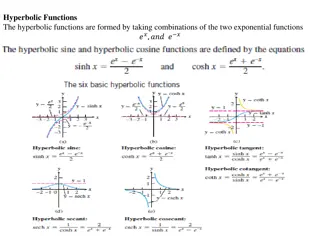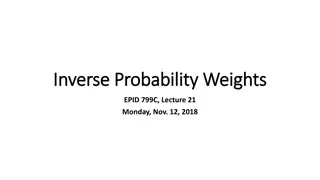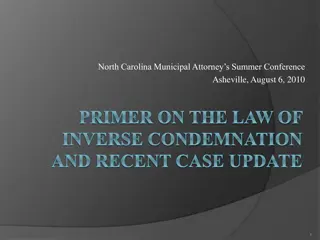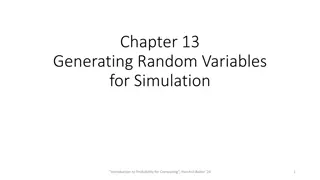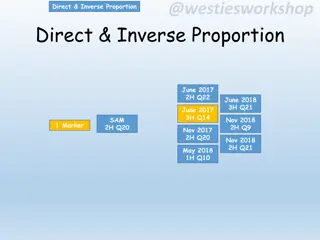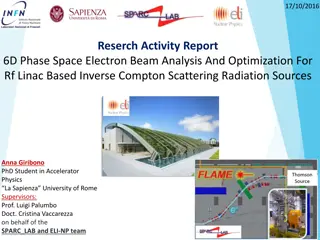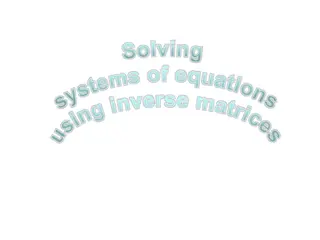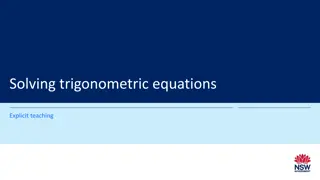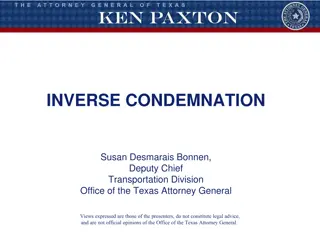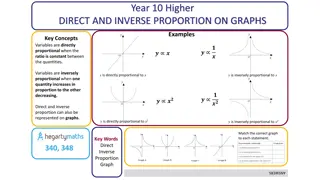Hyperbolic Functions and Their Inverses
This content delves into the world of hyperbolic functions, discussing their formation from exponential functions, identities, derivatives, and inverse hyperbolic functions. The text explores crucial concepts such as hyperbolic trigonometric identities, derivatives of hyperbolic functions, and integ
2 views • 9 slides
Inverse Probability Weights in Epidemiological Analyses
In epidemiological analyses, inverse probability weights play a crucial role in addressing issues such as sampling, confounding, missingness, and censoring. By reshaping the data through up-weighting or down-weighting observations based on probabilities, biases can be mitigated effectively. Differen
3 views • 25 slides
States Analogous to 12C Hoyle State in Heavy Nuclei Using Inverse Kinematics
The study discusses the search for states similar to the 12C Hoyle state in heavier nuclei through the thick target inverse kinematics technique. It explores alpha clustering in nuclei, the thick target inverse kinematics method, events with alpha multiplicities, and more experimental details relate
1 views • 19 slides
Inverse Condemnation Law in North Carolina
Explore the nuances of inverse condemnation law, including its history, basis in fundamental constitutional rights, N.C. statutory framework, attorney fees, and major categories of inverse takings. Learn about the actions, burdens of proof, and legal principles involved in these cases.
1 views • 36 slides
The Inverse Relationship of Addition and Subtraction
Learn about the inverse relationship between addition and subtraction through examples and visual aids. Practice writing inverse number sentences and understand how addition and subtraction are opposite operations that involve rearranging the same numbers in a different order.
3 views • 11 slides
Alpha Cluster Structure in Nuclei Using Thick Target Inverse Kinematics Technique
Exploring the alpha cluster structure of nuclei through the thick target inverse kinematics technique for multiple alpha decays. This study investigates alpha clustering in nuclei, potential alpha condensates, and the application of the inverse kinematics technique in detecting multiple alpha emissi
0 views • 14 slides
Flexible Framework for Stormwater Lids Modeling
A new flexible framework for forward and inverse modeling of stormwater lids is presented. It includes governing equations, hydraulic and contaminant transport, numerical methods, and demonstration cases for various green infrastructure components. The importance of different processes in modeling i
4 views • 20 slides
High-Resolution 3D Seafloor Topography Enhancement Using Kalman Filtering
Proposing a Kalman Filter approach to refine seafloor topography estimation by integrating various geophysical data types. The method allows for producing regional bathymetry with higher resolution, truncating unnecessary observations, and reducing the matrix dimensions in the inverse problem. Inclu
2 views • 9 slides
Generating Random Variables Using Inverse Transform Method
Explore the Inverse Transform Method for generating random variables in simulations. Learn how to map random instances to desired distributions, whether continuous or discrete, by understanding cumulative distribution functions and inverting them. Examples and step-by-step explanations provided for
9 views • 24 slides
Composite and Inverse Functions
Learn about composite functions, inverse functions, and how to find their compositions and inverses through examples and step-by-step explanations. Explore the concept of forming composite functions, verifying inverse functions, and finding the inverse of a function using interchange and solving met
1 views • 15 slides
Direct and Inverse Proportion in Mathematics
Exploring the concept of direct and inverse proportion in mathematics through various questions from past exam papers. The content includes images illustrating how these proportional relationships work in different scenarios.
2 views • 24 slides
Electron Beam Analysis and Optimization for RF Linac in Inverse Compton Scattering
This research activity report discusses the analysis and optimization of a 6D phase space electron beam for RF Linac-based Inverse Compton Scattering radiation sources. It covers the SPARC_LAB Thomson Source and ELI-NP GBS, including experiments, simulations, and studies on beam parameters and struc
2 views • 26 slides
Negative Numbers and Additive Inverse
Explore the world of negative numbers and additive inverse through a series of mathematical exercises. Learn how to calculate sums involving negatives and discover the concept of additive inverses, where adding a number and its opposite results in zero. Test your understanding with various numerical
2 views • 21 slides
Solving Systems of Equations using Inverse Matrices
Learn how to solve systems of equations using inverse matrices, find the determinant of matrices, use matrix multiplication, calculate the inverse matrix, and apply it to solve simultaneous equations. Explore examples and applications in investment scenarios.
4 views • 14 slides
Robotic Kinematics & Control: Exploring Parallel Robots & Delta Robots
Discover the fascinating world of robotic kinematics and control through the exploration of parallel robots, Stewart platforms, inverse kinematics, forward kinematics, multiple solutions, and Delta robots. From understanding the structure of control variables to solving kinematic equations, this con
4 views • 15 slides
Solving Trigonometric Equations with Inverse Functions
Learn how to solve trigonometric equations using inverse trigonometric functions with step-by-step examples. Understand the concept of sin⁻¹, cos⁻¹, and tan⁻¹ functions to find angles corresponding to specific trigonometric values. Practice solving equations and converting angles to degrees
3 views • 4 slides
Inverse Condemnation: Legal Aspects and Case Studies
Explore the concepts of inverse condemnation, Serbonian Bog references, and the legal implications in Texas jurisprudence. Learn about typical and atypical claims, challenges faced by plaintiffs and defendants, and notable cases such as Harris Cty. Flood Control Dist. v. Kerr. Delve into government
3 views • 21 slides
Gravity and Inverse Square Relationships in Physics
Explore the concepts of gravitational field, potential, geostationary orbits, escape velocity, and the inverse square relationship in Newton's Law of Universal Gravitation. Discover how mass and distance affect gravitational force and learn about nonuniform gravitational fields and equipotential lin
16 views • 22 slides
Inverse of Elementary Matrices & RREF Comparison
Inverse of elementary matrices explained with matrices operations, including row interchange, scaling, and row addition. How to find elementary matrices depicted step-by-step. Relationship between reduced row echelon form (RREF) and elementary matrices. The concept of invertible matrices and their r
3 views • 8 slides
7.4 Inverse Trig Functions
Learn about the diverse applications of inverse trigonometric functions in various fields such as actuarial science, aerospace engineering, mechanics, economics, and more. Understand the criteria for a function to have an inverse and explore the inverse sine, cosine, and tangent functions along with
2 views • 40 slides
Simultaneous Linear Equations and Matrix Algebra
Delve into the intricacies of solving simultaneous linear equations using matrix algebra. Explore the concept of finding the inverse of a matrix and understand the steps involved in setting up equations to find the inverse. Learn about forward elimination and back substitution in Gaussian eliminatio
2 views • 50 slides
Multiplication Inverse
The concept of multiplicative inverses in modular arithmetic, exploring the conditions where numbers have multiplicative inverses, and investigating the necessary and sufficient conditions for a number to have a multiplicative inverse modulo another number.
4 views • 28 slides
Key Concepts in Direct and Inverse Proportion on Graphs
Variables exhibit direct proportion when a constant ratio exists between quantities, while inverse proportion occurs when one quantity increases as the other decreases. This concept is visually represented on graphs, where direct proportion follows y = kx and inverse proportion follows y = k/x.
0 views • 6 slides
Inverse Functions and Graph Symmetry
In mathematics, we explore inverse functions, determine if they are also a function, and analyze their domain and range. The graphs of inverse functions are symmetric to the line y=x. By switching x and y in a function before squaring both sides, we can find the true inverse function graph. Let's de
2 views • 7 slides
Solving Inverse Kinematics in Manipulators: The Challenge of Workspace
Explore the complexities of solving inverse kinematics in manipulators, focusing on workspace considerations and limitations for achieving desired end-effector positions and orientations. Understand the dextrous and reachable workspace concepts and the impact of joint limits on manipulator capabilit
4 views • 16 slides
Exploring Inverse Compton Scattering at CLARA with Chris Arran
Discover the potential of Inverse Compton Scattering experiments at CLARA by Christopher Arran, focusing on fundamental QED processes and strong field effects. Explore simulations, plasma optics, and beam optimizations for enhanced results in photon beam research. Join the journey towards high-inten
5 views • 5 slides
Inverse Laplace Transform in Materials Engineering Department
Learn about the concept of inverse Laplace transform in the field of Materials Engineering Department. Understand the definition, properties, transform pairs, and the application of inverse Laplace transform through partial fraction expansion. Dive into numerical methods and data analysis in enginee
1 views • 13 slides
Inverse Relations and Functions Lesson 7
Students will learn about finding inverse functions, solving equations for simple functions with inverses, verifying functions through composition, reading values from graphs or tables, and creating invertible functions from non-invertible ones. Key vocabulary includes inverse functions and the hori
1 views • 34 slides
How to Find the Inverse of a 3x3 Matrix: Step-by-Step Guide
Learn how to find the inverse of a 3x3 matrix with clear steps and key definitions. Understanding the determinant, matrix of minors, cofactors, and completing the process to find the inverse matrix efficiently.
2 views • 10 slides
Utilizing Optimization for Inverse Modeling in Aquifer Characterization
Explore the application of Optimization interface in inverse modeling to estimate unknown parameters of aquifer characterization using COMSOL Multiphysics. Learn how to solve underdetermined optimization problems and evaluate the efficiency of the process. The model simulates the flow in an aquifer
3 views • 13 slides
Function Machines and Inverse Operations in Mathematics
Explore the concept of function machines with multiple operations, solve missing values, and learn about inverse operations to reverse functions. Practice writing inverse functions and draw function machines to understand the process better.
0 views • 14 slides
Inverse Functions and Their Applications
Explore the concept of inverse functions, how they are defined, and learn how to determine the inverse function of a given function through examples. Discover the rules and methods for finding inverse functions analytically.
1 views • 13 slides
Understanding Inverse Functions in Mathematics
Learn about inverse functions and their properties in mathematics, including definitions, notations, examples, and theorems. Explore the concept of bijective functions and their connection to inverse relations. Dive into the world of functions and uncover the intricacies of this fundamental mathemat
4 views • 22 slides
Understanding Inverse Functions in Mathematics
Learn about inverse functions in mathematics, including their definition, examples, and how to determine if a function is one-to-one. Discover the Horizontal Line Test and the concept of inverse functions for one-to-one functions.
3 views • 10 slides
Understanding Functions and Inverse Functions in Mathematics II
Explore the definitions and properties of inverse functions, functions, and their notation. Learn through examples and theorems how to determine if an inverse function exists and its characteristics in the realm of mathematics.
3 views • 22 slides
Inverse Laplace Transform Tutorial and Differential Equations Solving
Explore the concept of inverse Laplace transform and its applications in solving differential equations. Learn about Laplace transforms, inverse transform methods, and differential equation solutions achieved through this powerful mathematical tool.
4 views • 28 slides
Understanding Inverses of Functions
Explore how to find the inverse of functions, graph the relationship between a function and its inverse, identify the line of symmetry, and use visual techniques to draw the inverse graph accurately. Learn practical methods to graph the inverse and verify the results using mathematical tools.
0 views • 19 slides
Understanding Direct and Inverse Variation
Learn about direct and inverse variation in mathematics, including how two quantities are related, the concept of proportionality, and solving problems involving direct or inverse variation. Explore examples illustrating direct variation with step-by-step solutions.
1 views • 14 slides
Optimized Inverse Method for SST Retrieval
Explore the deterministic inverse method for SST retrieval from VIIRS and how aerosols are incorporated in the retrieval process. Learn about the physical retrieval process, history of inverse models, uncertainty estimation, and analysis of retrieval errors. Understand the optimization techniques an
0 views • 16 slides
Understanding Identity and Inverse Functions
Explore the concepts of identity and inverse functions to understand their relationship and how to find inverse functions. Learn how to determine if two functions are inverses of each other by composition and solve for inverse functions algebraically. Discover the graphical representation of inverse
2 views • 12 slides
